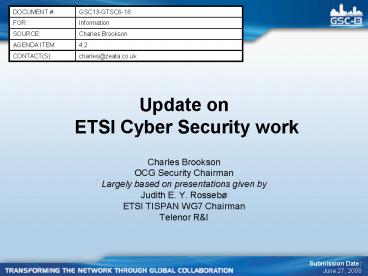Update on ETSI Cyber Security work - PowerPoint PPT Presentation
Title:
Update on ETSI Cyber Security work
Description:
... Threat and risk analyses for specific NGN use cases such as NAT traversal, RACS, Media Security, and Unsolicited Communication; NGN Security architecture ... – PowerPoint PPT presentation
Number of Views:79
Avg rating:3.0/5.0
Title: Update on ETSI Cyber Security work
1
Update on ETSI Cyber Security work
DOCUMENT GSC13-GTSC6-18
FOR Information
SOURCE Charles Brookson
AGENDA ITEM 4.2
CONTACT(S) charles_at_zeata.co.uk
- Charles Brookson
- OCG Security Chairman
- Largely based on presentations given by
- Judith E. Y. Rossebø
- ETSI TISPAN WG7 Chairman
- Telenor RI
Submission DateJune 27, 2008
2
ETSI TISPAN WG7
- NGN concept fixed-mobile network convergence to
packet-switched technology delivering multimedia
services - ETSI TISPAN is extending the 3GPP IMS concepts in
designing NGN - TISPAN Working Group 7 is the NGN competence
centre for security with a group of security
experts standardizing NGN security
www.tispan.org
3
TISPAN NGN
- ETSI TISPAN proposes an architecture basis
consisting of a range of subsystems - Access network attachment subsystem (NASS)
- Resource and admission control sub-system (RACS)
- PSTN-ISDN emulation subsystem (PES)
- IP Multimedia Subsystem (IMS) (3GPP)
- IPTV Subsystem
- TISPAN is adopting standards from other bodies
where appropriate - Aspects relating to common IMS are not
standardized by TISPAN, but if identified shall
be transferred to the responsibility of 3GPP
Telecommunication and Internet converged Services
and Protocols for Advanced Networking
4
TISPAN NGN Architecture
5
TISPAN NGN R1 security
- NGN Security requirements (TS 187 001)
- NGN eTVRA (TR 187 002)
- Threat and risk analyses for specific NGN use
cases - NGN Security architecture (TS 187 003)
- NGN Lawful Interception functional entities,
information flow and reference points (TS 187
005)
6
TISPAN NGN R2 security (1/2)
- NGN Security requirements (TS 187 001)
- Builds on the R1 version of the TS
- Defines also security requirements for IPTV,
Business Communication, Media Security, Home
Networking, and for countering UC - NGN eTVRA (TR 187 002)
- Threat and risk analyses for specific NGN use
cases such as NAT traversal, RACS, Media
Security, and Unsolicited Communication - NGN Security architecture (TS 187 003)
- Work is ongoing on defining the security
architecture for IPTV, Home Networking, FMC,
Media Security, H.248, Corporate Networks - NGN Lawful Interception functional entities,
information flow and reference points (TS 187
005) - Builds on the R1 version of the TR
7
TISPAN NGN R2 security (2/2)
- Generalized NAT traversal feasibility study (TR
187 007) - TB approved December, 2007
- Media security (TR 187 008)
- Impact of unsolicited communication in the NGN
- New work item on data retention and its impact on
the NGN
8
NGN Feasibility Studies Feed into TISPAN Core
Security Documents
9
Topics for future work
- TISPAN NGN security beyond Release 2
- IPTV security (enhancement of stage 2, definition
of stage 3) - Adding UC prevention as a feature (stage 1, stage
2, stage 3) - Media security provisioning (stage 1, stage2)
- Additional work on NAT-T (e.g. interaction with
RACS, interaction with IPTV, security analysis of
use of STUN) - Enhanced security for NASS, RACS
- Security for CNG/CND (stage 1, stage 2, stage 3)
- Implications for AGCF security
- Security for NGCN
- FMC (taking into account requirements of the
FMCA) - Diameter and Radius AVP profiling
- Application layer security on the NGN (e.g. TELCO
2.0) - Analyse the inter-relation between security
features and architecture of the NGN (IPTV,
NAT-T, NASS, RACS etc.) in terms of how to employ
consistent security architecture and mechanisms - Develop general rules, patterns, and templates to
ease the employment of the NGN in practice and to
facilitate risk control































